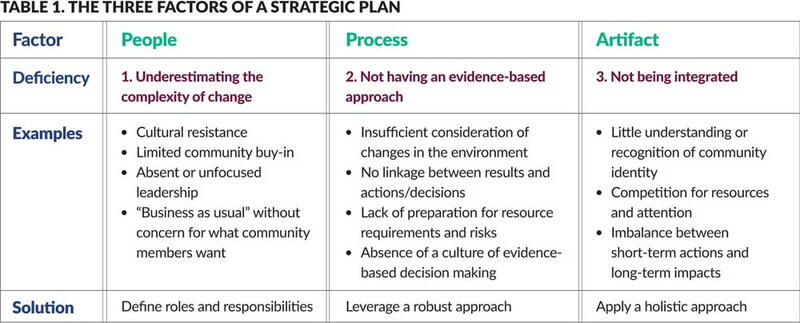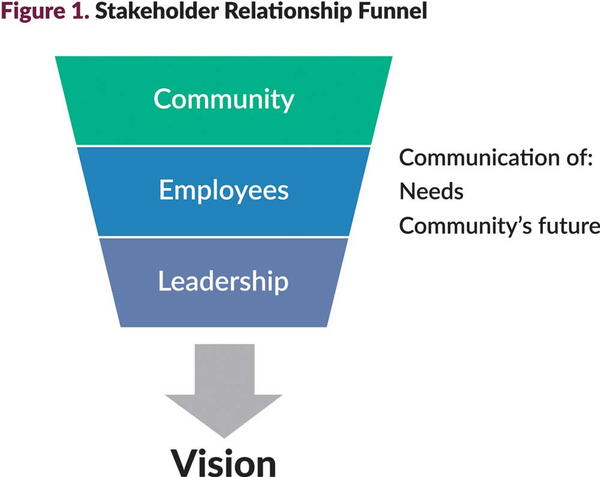
By Kel Wang and Michael Sambir
As a manager, you know that approving a strategic plan is one of the most important decisions any city/county governing body makes. It also establishes the foundation and scope for your organization’s performance management program. But what are the factors you need to consider to manage this work? Here we present a diagnostic tool (Table 1) to help you prepare and present your plan in confidence.
This tool is drawn from our experience developing and updating the strategic plan for Edmonton, Alberta, Canada. The factors that are important to consider are (1) the people involved, (2) the process, and (3) what we call the “artifact,” which means the structure and components of the plan, including the publication and its content.
These three factors will require attention throughout the development of your strategic plan. Challenges can arise at any time, but for the sake of illustration we’ve set out the three factors in a linear fashion starting at the very beginning of developing a strategic plan. So what is the first thing that needs attention?

People: Define Roles and Responsibilities
You and your team have researched best practices and looked at examples of strategic plans. You have brainstormed and created a project plan with timelines and milestones. You think you’re all set to go.
But you may have underestimated the complexity of managing change, and several barriers can stand in the way: The organizational culture resists what the plan sets out; the community isn’t ready to buy in to it; leadership is absent or unfocused; or business units keep doing what they’ve always done, with no concern for what the “customers” (read: community members) want.
The solution to the “people” barriers begins with one action: defining roles and responsibilities for key stakeholders. Once these are defined, you can develop frameworks for governance and engagement. In the local government sector, you as an organizational leader have to consider three key stakeholder groups involved in developing and implementing the plan: elected leaders, employees, and the community.
1. Elected leaders.
The chief role of elected leaders is to provide the vision, or the big picture, of what they seek to achieve. They should not be engaged in prescribing actions or managing activities for implementing the strategic plan. Instead, their responsibility is to demonstrate the organization’s commitment by being visible and present through the process of implementation. The single most effective way of doing this is through active, two-way communication with those who will be implementing, or affected by, the strategic plan: organizational employees and the community.
2. Organizational leaders and employees.
Organizational leaders and employees implement the strategic plan by developing and managing the activities that lead to the achievement of its goals and objectives. The role of organizational leaders—including the chief administrator, senior managers, and middle managers—is to empower staff and employees to do that work. Empowerment will increase employees’ ownership and improve the chances of success. Another critical role of employees is to act as the interface with community members, serving as the conduit of information to and from the community.
3. Community.
Government should serve the people. In the best case, the strategic plan is directly informed by what the community wants. The accompanying sidebar, “Strategic Planning in Edmonton,” describes the city’s approach. A key measure is how successfully the strategic plan engages the community and meets its needs. The most critical role for the community is to provide feedback on what matters to it. This should occur at the beginning, when a new plan is being considered and then developed; during the middle, when it is being implemented; and at the end, when it is in place and being used to weigh and prioritize opportunities, make decisions, and shape services.
We can think about these three participants and the relationships among them as a funnel (Figure 1). The community communicates its needs and hopes for the future through employees. Elected leaders distill that into a vision. Developing and implementing a strategic plan calls for visible leadership to engage employees and the community, so that the organization can achieve what the community has said is important.

As an organizational leader, you will not have a physically visible role in creating the strategic plan; your responsibility is to be a behind-the-scenes catalyst for the work: you empower employees and foster an organizational culture that puts community front and center.
Process: Use a Robust, Evidence-Based Approach
You’ve created the plan through proper engagement. The plan contains a long-term vision articulated by goals and objectives and has indicators or measures to monitor progress and results. Implementation is next. But you may have just missed a critical component: evidence to inform your decisions.
You’ll face challenges, and evidence will help you find the way forward. For example, the plan doesn’t sufficiently consider a changing environment; the organization’s activities have very limited influence on the results of indicators or measures so the decisions or actions to improve the results aren’t clear; or implementation is not considered during planning so people are surprised by potential resource requirements and risks.
The solution is to have a robust approach before beginning to develop the actual plan and continuing through development and beyond.
1. Before development.
Communities are different, and each has its own set of macro-environmental conditions that the strategic plan must consider. Knowing these conditions will help inform decisions about which opportunities the community should capitalize on and which actions the plan should evaluate. It will also help identify threats to the community that may require attention. Typical conditions to consider include the political climate, the economy, social and cultural factors, the environment, technology, and legislation.
2. During development.
The development of the actual plan should be governed by what you’re trying to achieve. And to understand that you’ll need to develop a set of indicators or measures to guide decision making (i.e. , what actions will you undertake to effect change in these indicators?). The indicators you select will help you begin to understand, at a high level, the costs of implementation. What kinds of indicators do you need? A sound indicator will be useful when it is:
- Specific: It needs to demonstrate a clear linkage to goals and objectives.
- Measurable: It can be measured and reported in quantitative or clear qualitative terms.
- Actionable: It can be influenced by a specific local government program or other activities.
- Realistic: Its target or goal can be realistically achieved, given available resources.
- Timely: It can be produced in a time frame that permits meaningful reporting.
Comparing your indicators or measures against those of other organizations or best practices (benchmarking) adds an additional and valuable lens to your selection.
3. After development.
Create an ongoing culture of evidence-based decision making. Setting up and using a robust approach before and during development is just the beginning. The real work begins when the plan is in place: While developing a plan is important, it is also critical to ensure that this evidence-based approach will be in place and sustained during the entire life cycle of the strategic plan.
Creating this culture will involve all the stakeholders described earlier: elected leaders, organizational leaders and employees, and the community. Organizational leaders foster this culture. Elected leaders promote and demonstrate the importance of this culture by their actions. Employees support this culture by making reliable data available in a timely fashion and presenting data with solid and creative analysis and visualization. The community advocates and advises using data and holds the government accountable to its expectation and commitment based on results and targets.
When embedded before, during, and after development, the evidence-based approach can be achieved.
Artifact: Apply a Holistic Approach
You planned ahead to address the issues with people and process: You are now confident people will be engaged and the process will result in good decision making. There is only one final step: an integrated organization.
Lack of integration means that the strategic plan will convey little understanding or recognition of your identity (what you stand for and how you will achieve it), and there will be competition for resources and attention between goals and objectives, or an imbalance between short-term actions and long-term impacts. The solution is a holistic approach that takes three things into account when you create the structure and components of the plan.
1. Highlight community identity.
Does your strategic plan present your identity—that is, who you are as a community? The idea is simple: You cannot be all things to all people. Today’s world is mobile and fluid. You need to recognize who and what your community is, to itself and to people beyond your boundaries. Knowing your identity is essential to presenting yourself as a choice. People choose where to live, work, and play, so recognizing and understanding who and what your community is helps define you to those who would choose to come, or choose to stay. So being holistic in identity is about recognizing the unique political, material, and social value conditions of your community and including these key attributes as part of your strategic plan. This is what makes your plan a reflection of your community.
2. Focus resources on community priorities.
Can you achieve what you set out to do in the strategic plan? Developing a plan with goals and priorities will help you consider trade-offs and help focus on the things that matter most to the community. If everything is important, then nothing really matters. So being holistic in resources is about allocating and re-allocating organizational resources (i.e. , human and financial resources) to achieve the goals and objectives. It signals priorities for actions and decisions.
3. Balance short-term actions and long-term impacts.
Is the strategic plan your North Star when it comes to decision making and actions? “Short-termism” refers to decisions and actions that focus excessively on short-term results without considering longer-term consequences. Having a strategic plan will extend the horizon on decision making, pushing you to consider those longer-term impacts. Ideally the plan should extend beyond the next one or two election cycles while at the same time encouraging timely (annual or biennial) reporting.
You know you have taken a holistic approach when your strategic plan highlights the identity of your community, allocates resources to community priorities, and makes a long-term commitment with timely reporting.
A Complex Undertaking
As noted before, approving a strategic plan is one of the most important decisions any governing body makes. For that reason, the development and implementation of the plan is complex and challenging.
Whether your role is to develop, present, or approve the plan, you need to remember that all three factors outlined in Table 1 are integral and should be aligned. Figure 2 presents another way to look at the three factors. People, process, and artifact lead to a successful strategic plan with long-term transformational impact for the communities we serve.

Sidebar: Strategic Planning in Edmonton
By Kel Wang
In both cases, to develop and renew the plan, the city undertook extensive engagement with the public. For example, to renew the plan in 2018, the city leveraged a comprehensive engagement approach, including facilitated discussions, drop-in public meetings, telephone and online surveys to engage the general public, and pop-up sessions to engage hard-to-reach or marginalized populations. The approach focused on seeking diverse opinions and experiences to take in a wide spectrum of information.
The results were enormously positive: 6,407 participants in sessions and surveys; 9,094 social media engagements (e.g. , clicks, reshares, likes, and comments on Facebook, Twitter, and Instagram); and 3.9 million digital and display impressions. We knew we had reached members of the community when we saw a note to the mayor and a council member from a sixth-grade student at an Edmonton elementary school.
The feedback was used to refine the city’s long-term vision, shape its strategic goals, and create the principles to guide the implementation. The general public demonstrated an increased understanding of city programs and services, caring about the community, and possible interest in public service.

Prioritization
Based on community feedback and the city council’s direction, the strategic plan contains four strategic goals on which the city will focus: Healthy City, Urban Places, Regional Prosperity, and Climate Resilience. The strategic plan and the four strategic goals then cascade down to a corporate business plan that outlines the administration’s priorities in the next four years: 2019-2022. The corporate business plan includes a set of transformational projects, programs, and everyday services, improvement initiatives, and capital infrastructure projects. The city will work hard to implement these priority actions in order to advance the strategic goals.
Employee Engagement
The strategic plan allows city staff to connect their work to the city’s vision and strategic goals and understand how their work will affect the community. The line of sight between city vision, strategic goals, priority action results, and day-to-day work adds clarity to the value of employees’ work. Parallel to the development of the strategic plan, the city created a set of culture commitments to guide how the work is approached and how it is done: safe, helpful, accountable, integrated, and excellent. These commitments play an important role in how city staff serve residents and provide internal services to colleagues.
Approving the strategic plan is one of the most important decisions any governing body makes, and the development process is as important as the plan itself. Both the process and the artifact (the structure and components of the plan) will lead to community building, common priorities, and engaged staff. These are the key benefits that creating a strategic plan offers a local government.


Endnotes and Resources
1 https://www.edmonton.ca/city_government/documents/ConnectEdmonton_Book_Web.pdf
New, Reduced Membership Dues
A new, reduced dues rate is available for CAOs/ACAOs, along with additional discounts for those in smaller communities, has been implemented. Learn more and be sure to join or renew today!
